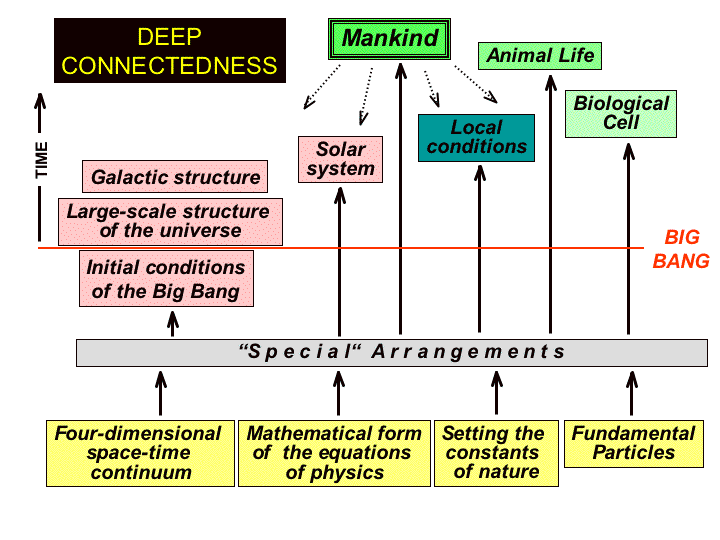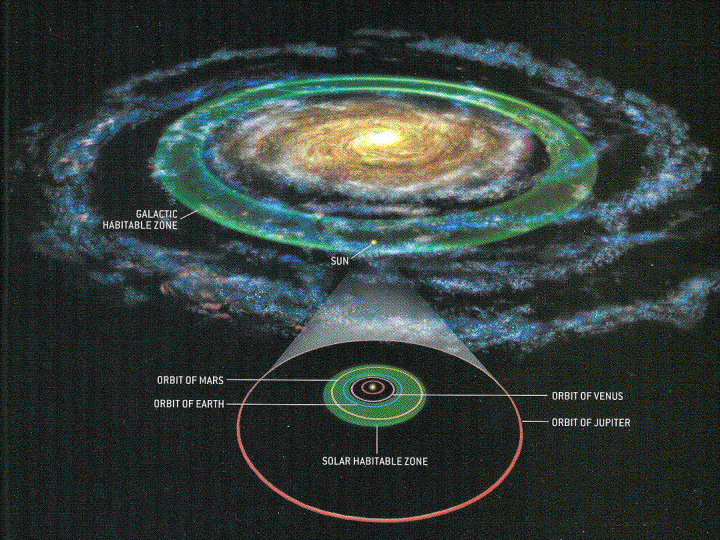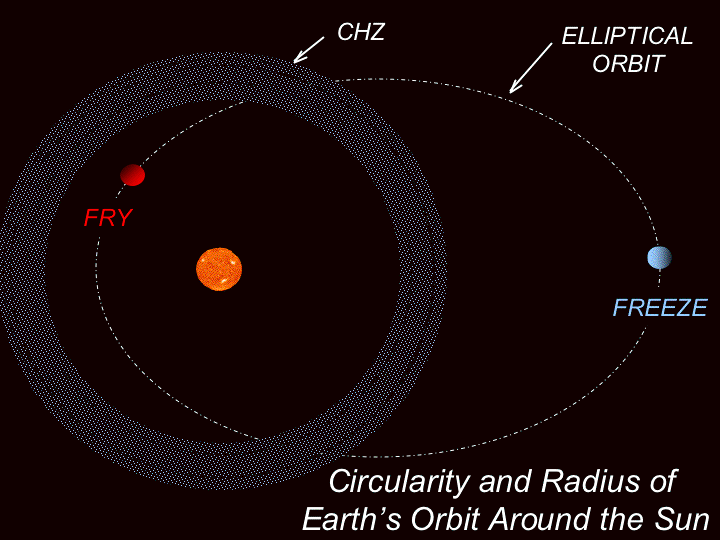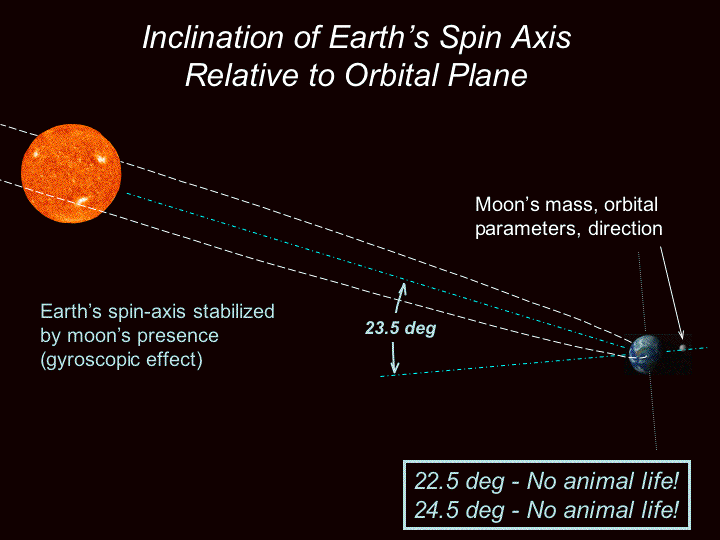Second BIG challenge to naturalism - vanishingly low probability that so many fundamental properties of the universe could be precisely as required for life to exist.
There is now broad agreement among physicists and cosmologists that the universe is in several respects ‘fine-tuned' for life.P. Davies Int. J. of Astrobiology 2(2): 115, (2003).

fine-tuning aspects of our universe, or the "anthropic coincidences"

habitable zone in a spiral galaxy


habitable orbit around the sun

tilt of the earth's axis of rotation

Some other examples:
1) Explosive power of the creation event precisely matched to power of gravity; density precisely matched with critical density, cosmological constant
If the force of explosion was only slightly higher, the universe would only consist of gas without stars, galaxies, or planets. Without stars, galaxies and planets, life could not exist. The matching had to be to the remarkable precision of one part in 1055. ... Some physicists believe that one explanation can be found in a model of an inflationary epoch at about 10-35 of the first second where a short period of accelerated expansion caused the perfect balance between gravity and the rate of expansion and density and critical density. This could explain the very flat characteristics of the universe given by these precise matchings, but the inflation required in this model would itself require an extraordinary fine tuning to yield the precisely balanced result. If the inflationary model is true, the inflationary epoch would contain enormous fine tuning and the precision of values issue is only removed one step.D. Overmann, A Case Against Accident and Self-Organization, pg 130-132.In any case, there is one constant whose value does seem remarkably well adjusted in our favor. It is the energy density of empty space, also known at the cosmological constant."
S. Weinberg, Skeptical Inquirer, Sept./Oct. 2001, pg 67.At the Nature of Nature conference at Baylor Unviersity, April 2000, Weinberg stated that the cosmological constant appears to be fine-tuned to 1 part in 10120.
In response to a question as to whether inflation eliminates the need for fine-tuning, Alan Guth commented:
"As far as finely tuning things, there are still two important fine tuning problem that are not solved. One is the problem that's called the cosmological constant problem. It's basically the problem of why the energy density of the vacuum is either zero or very close to being zero. Current models of physics require fine tuning in order to make the energy of the vacuum turn out to be either zero or very, very small."Alan Guth, quoted by F. Heeren in "Show Me God", pg 387.
A straightforward estimation suggests that empty space should weigh several orders of magnitude of orders of magnitude (no misprint here!) more than it does. It "should" be much denser than a neutron star, for example. ... To me, the discrepancy concerning the density of empty space is the most mysterious fact of all of physical science, the fact with the greatest potential to rock the foundations. We're obviously missing some major insight here.
Frank Wilczek, Physics Today, Oct. 2003 pg 10-11.At present it is clearly too early to choose one cosmological model over the other. It is getting increasingly difficult to find accord with a flat universe without a cosmolgocial constant. The question then becomes: Which fundamental fine-tuning problem is one more willing to worry about, the flatness problem or the cosmological constant problem? The latter involves a fine-tuning of over 120 orders of magnitude, if the cosmological constant is nonzero and comparable to the density of clustered matter today, while the former involves a fine-tuning of perhaps only 60 orders of magnitude, if one arbitrarily fixes the energy density of the universe at the Planck time to be slightly less than the closure density.
L. M. Krauss, The Astrophysical Journal, 1998, 501: p 465.Although Einstein dismissed the cosmological constant as a personal blunder, quantum mechanics makes it obligatory. Unfortunately, even the best quantum "mechanics" have failed to produce a sensible prediction for L. The sum of zero-point energies diverges due to short-wavelength modes. Truncating at an energy scale beyond which we can appeal to physics ignorance illustrates the enormity of the problem: for a 100-GeV cutoff, WL - 1055. This disparity is the greatest embarrassment in all of theoretical physics.
Michael S. Turner, Physics Today, April, 2003.
"This is an incredibly highly ordered event, extremely highly ordered, its just the opposite of a chaotic event."
Eric Carlson, Senior astronomer at the Adler Planetarium, in an interview with Fred Hereen shown in the video "Scientific Evidence For God"2) ripples in the cosmic microwave background
The pattern demonstrates that the event was not a haphazard event. The fluctuations had to be just as they were for galaxies to form and life to be possible.
"If your religious, it's like looking at God"
George Smoot, quoted by Milton Rothman in Free Inquiry, vol 13, no 1, 1992.1993 pg 12."The big bang, the most cataclysmic event we can imagine, on closer inspection appears finely orchestrated"
G. Smoot and Davidson, "Wrinkles in Time", 1993, 135."the most important discovery of the century, if not of all time"
S. Hawking quoted by G. Smoot and Davidson, "Wrinkles in Time" 1993, pg 283."The first loose end has to do with the presence of galaxies and large-scale structure. ... these huge structures could not exist today unless the seeds for their formation had been present in the early universe. However, the standard Big Bang theory says nothing at all about how such seeds might have come to exist. The only explanation the theory allows is that they were "already there" at the instant of creation and were not destroyed by the subsequent heat. ...
Finally, our first loose end, concerning the origin of the seeds around which galaxies and larger structures grew, is tied up quite easily. ... Thus inflation says that the seeds for galaxies arose naturally from the amplification of tiny quantum ripples.
J. Bennett, On the Cosmic Horizon, pg 124, 130.Inflation is a wonderfully attractive, logically compelling idea, but very basic challenges remain. Can we be specific about the cause of inflation, and ground it in explicit, well-founded physics? To be concrete, can we calculate the correct amplitude of fluctuations convincingly? Existing implementations actually have a problem on that score; getting the amplitude sufficiently small takes some nice adjustment.
Frank Wilczek, Physics Today, Oct. 2003 pg 10.
Davies, Ellis, and others argue that such inflation would itself have needed very accurate tuning to occur at all and to leave roughness of just the right amount to lead to galaxies. Two components of an inflation-driving "cosmological constant" might have had to balance each other with an accuracy of better than one part in 1050.John Leslie, "The Anthropic Principle today", in Modern Cosmology & Philosphy, pg 291.In response to a question as to whether inflation eliminates the need for fine-tuning, Alan Guth commented:
"As far as finely tuning things, there are still two important fine tuning problems that are not solved. ... The second problem is more directly related to inflation. The cosmic background radiation is uniform in temperature to about one part in a hundred thousand. In order to get these nonuniformities to be as small as what we observe, we have to arrange that certain numbers that describe the underlying particle physics be very, very small, for reasons which we do not, at the present time, understand."Alan Guth, quoted by F. Hereen in "Show Me God", pg 387.
3). the existence of elements necessary for life
"How is it that common elements such as carbon, nitrogen, and oxygen happened to have just the right kind of atomic structure that they needed to combine to make the molecules upon which life depends? It is almost as though the universe had been consciously designed."4). ratio of mass of proton to mass of electron (1,836)Richard Morris, The Fate of the Universe, 1982, 155."A common sense interpretation of the facts suggests that a superintellect has monkeyed with physics, as well as with chemistry and biology, and that there are no blind forces worth speaking about in nature. The numbers one calculates from the facts seem to me so overwhelming as to put this conclusion almost beyond question."
Fred Hoyle, "The Universe: Past and Present Reflections", Annual Reviews of Astonomy and Astrophysics, 20 (1982), 16."Without such accidents water could not exist as a liquid, chains of carbon atoms could not form complex organic molecules, and hydrogen atoms could not form breakable bridges between molecules"
Freeman Dyson, Disturbing the Universe,1979, 393.
If this ratio were slightly different there would be no chemistry, and no life. S. Hawking cites this example as one of the many fundamental numbers in nature, and he says"The remarkable fact is that the values of these numbers seem to have been very finely adjusted to make possible the development of life".
S. Hawking, A Brief History of Time,1988, pg 125.
5). the magnitude of each of the four fundamental forces
"The bulk of the carbon in our universe is produced in the triple-alpha process in helium-burning red giant stars. We calculated the change of the triple-alpha reaction rate in a microscopic12-nucleon model of the 12C nucleus and looked for the effects of minimal variations of the strengths of the underlying interactions. ... We conclude that a change of more than 0.5% in the strength of the strong interaction or more than 4% change in the strength of the Coulomb force would destroy either nearly all C or all O in every star.H. Oberhummer, A. Csoto, H. Schlattl, SCIENCE 289, July 7, 2000, pg 88.
"Every one of these forces must have just the right strength if there is to be any possibility of life. For example, if electrical forces were stronger than they are, then no element heavier than hydrogen could form. ... But electrical repulsion cannot be too weak. If it were, protons would combine too easily, and the sun. ... (assuming that it had somehow managed to exist up until now) would explode like a thermonuclear bomb."6-?). etc, etc.Richard Morris, The Fate of the Universe, 1982, pg 153."If the strong nuclear force were even 0.3 % stronger or 2% weaker the universe would never be able to support life."
Barrow and Tipler, Anthropic Cosmological Principle, 318-327, 354-359.
(many books have been written about this, long lists of such facts are now available)
Naturalistic alternatives in the face of the anthropic coincidences?
The Anthropic Principle (weak, strong, participatory, final, or WAP, SAP, PAP, and FAP)Barrow and Tipler, The Anthropic Cosmological Principle
1. In one view, there must be an infinite number of universes. We exist in the one where all the constants and laws are just right for life, because that is the only one in which life could have evolved!
supported in one form or another by Weinberg, Guth, among others
Some published comments on this proposal:
"Extreme multiverse explanations are . . . reminiscent of theological discussions. Indeed, invoking an infinity of unseen universes to explain the unusual features of the one we do see is just as ad hoc as invoking an unseen Creator. The multiverse theory may be dressed up in scientific language, but in essence it requires the same leap of faith."Paul Davies, Op-Ed in the New York Times, "A Brief History of the Mulitverse", Apr. 12, 2003.
"What should we make of this quartet of WAP, SAP, PAP, and FAP? In my not so humble opinion I think the last principle is best called CRAP, the Completely Ridiculous Anthropic Principle."Martin Gardner, The New York Times Review of Books, 23 (May 8, 1986), 22-25.
"Oh yes, I talk about that anthropic principle, but I don't give any much credence to it."Robert Jastrow, quoted by F. Heeren in "Show Me God", pg 377"I do not have confidence in its use. It has little predictive power."
George Smoot, quoted by F. Heeren in "Show Me God", pg 377.
2. Another view is that there must be an infinite number of histories to our universe in imaginary time.
"As I said earlier, even if the boundary condition of the universe is that it has no boundary, it won't have just a single history. Instead, the histories in imaginary time will correspond to very possible closed surface. Each history in imaginary time will determine a history in real time. Thus, we have a super abundance of histories for the universe. What picks out the particular history, or set of histories that we live in, from the set of all possible histories of the universe?
One point that we can notice, is that many of these possible histories of the universe, won't go through the sequence of forming galaxies and stars, that was essential to our own development. It may be that intelligent beings can evolve without galaxies and stars, but it seems unlikely. Thus the very fact that we exist, as beings that can ask the question, Why is the universe the way it is, is a restriction on the history we live in. It implies it is one of the minority of histories that have galaxies and stars.
This is an example of what is called the Anthropic Principle. The Anthropic Principle, says that the universe has to be more or less as we see it, because it if were different, there wouldn't be anyone here to observe it.
Many scientists dislike the Anthropic Principle, because it seems rather hand waving, and not to have much predictive power. But the Anthropic Principle can be given a precise formulation, and it seems to be essential, when dealing with the origin of the universe."
Steven Hawking, "The Universe in a Nutshell", at the Centennial meeting of the American Physcial Society, March 1999.